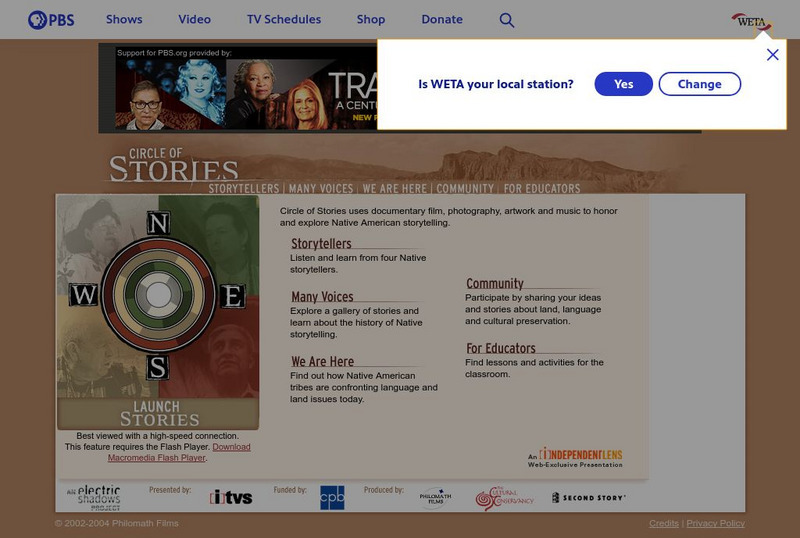Curated OER
What Are the Seasons?
First graders explore seasons and how they are part of a continuous circle.
Curated OER
Raleigh Bound!! A Virtual Tour
Fourth graders navigate a DPI web site to answer questions as they preview the Capitol, Legislative Building, and Museum of Natural Sciences before an actual trip to Raleigh.
Curated OER
Lesson 2: Mapping With Words
Students demonstrate an understanding of the personal relationship that Wabanaki peoples had with the land by analyzing selected Wabanaki place names. They practice map-reading and map-making skills.
Curated OER
Inventions over Time
Sixth graders examine inventions, such as spear points and bows and arrows, and discuss their importance in human cultural development. They compare these early inventions with modern ones and determine the impact of science and...
Curated OER
Whose Rock Is This Anyway?
Students will seek to understand the events at Pipestone Quarry and what may have caused them. Pipestone Quarry in Pipestone, Minnesota, bears the mythic red Sioux quartzite called Pipestone or Catlinite.
Curated OER
Care to Canoe?
Students experience to balance with another student and maneuver in a two person canoe on still water. They analyze important aspects of canoeing including putting in, portaging and weight distribution. Students discuss the...
Curated OER
IN STRAWBERRY FIELDS
The student will calculate wages of agricultural workers by the hour and by the piece.2. Share background material, and discuss the difference between gross pay and net pay and the difference between getting paid by the hour or the piece...
Curated OER
Hawaii's Future Tied to History
Students investigate Hawaii's history to help them explain how a Reorganization Act may affect its residents. students track the region's history from statehood, to kingdom, to human settlement.
Curated OER
"Architexture": Exploring Architecture Through Clay Tiles
Students explore and analyze the architecture of San Antonio, Texas. They watch a video about tiles created by Harding Black, and discuss pictures of architecture found in San Antonio, Texas. Students then design a clay tile...
Curated OER
The Bulbs: Camas and Daffodil
Fourth graders become aware of the importance of the camas bulb to the Nez Perce people, they learn the parts of plants, and gain understanding of the interdependence of Nature. They study about the possible causes and outcomes of global...
Curated OER
Walt Disney World
Fifth graders increase their reading, speaking, and listening comprehension skills on the basis of cultural practices.
Curated OER
Spain and France Influence in Europe and in the New World
Learners examine the conditions in France and Spain during the Middle Ages and the Discovery of America. In groups, they compare and contrast the political situations in both countries and what effect they had on the New World. To end...
Curated OER
From One Seed Grow Many Seeds
First graders practice identifying plants by singing a song. In this plant life lesson, 1st graders sing the song "Parts of a Plant" which is based on the anatomy of sunflowers. Students discover agriculture techniques while...
Curated OER
Remember
In this phrases representing remembering worksheet, learners complete multiple choice questions where they fill in the blanks to sentences with phrases representing remembering. Students complete 20 sentences.
Curated OER
An International Menu
Students research etymologies using dictionaries. They explore the diverse origins of the common foods they eat after making a list of their favorite foods.
Curated OER
Adapted to Fire
Fourth graders explore forest species' adaptations to fire by participating in a scavenger hunt and mapping a burned forest. Students create maps and explore how indigenous species adapted to living with fire.
Curated OER
Volcanoes: How Safe Are They?
Students explore the most dangerous volcanoes on Earth, plot their locations, and research different volcanic hazards.
Other
Bringing History Home: Native American History
This 5th grade unit is an introduction to Native American history in the 19th and 20th centuries. The lessons focus on U.S. government policies that have determined the official relationship between the government and Native American...
Children's Museum
The Children's Museum of Indianapolis: Native Americans and the Natural World
Explore the rich cultures of Native Americans through literature, storytelling, and fun, hands-on activities. Students will gain an understanding of how and where Native Americans lived in the past and today, as well as their...
National Geographic Kids
National Geographic Kids: Native Americans
This is a collection of eight readings about Native Americans each from a different region of the United States. Each discusses how they got there, their culture, their life today, and photos and slide shows.
Other
History Today: Native Americans and the Federal Government
Andrew Boxer traces the origins of a historical issue still as controversial and relevant today as in past centuries. At the start of the twentieth century there were approximately 250,000 Native Americans in the USA - just 0.3 per cent...
Library of Congress
Loc: Today in History: June 2: Indian Citizenship Act
On June 2, 1924, Native Americans were granted American citizenship via Indian Citizenship Act. Learn about this act of congress and how it impacted American Indian culture.
PBS
Pbs: Circle of Stories
This PBS series site captures Native American stories told by the storytellers themselves. Students can also find information on language and land issues confronting Native Americans today.





















